Temburong District
| |
|---|---|
.jpg.webp) 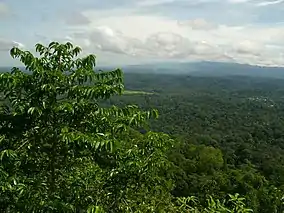  .jpg.webp) Clockwise from top left: Bangar Town, Peradayan Forest Reserve, a commercial complex in Bangar, a longhouse in Temburong | |
| Nickname(s): | |
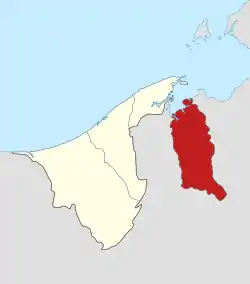 | |
| Country | Brunei |
| Administrative centre | Bangar |
| Area | |
| • Total | 1,306 km2 (504 sq mi) |
| Population (2016)[3] | |
| • Total | 10,251 |
| • Estimate (2020)[3] | 11,200 |
| • Density | 7.8/km2 (20/sq mi) |
| Time zone | UTC+8 (BNT) |
| Postcode | P |
| Area code | 5 |
| Website | temburong.gov.bn |
Temburong District (Malay: Daerah Temburong; Jawi: دائيره تمبوروڠ), or simply Temburong (Malay: [tǝmburoŋ] ⓘ) is the easternmost district in Brunei. It is an exclave surrounded by Malaysia and the Brunei Bay. Temburong is accessible from Brunei's mainland via the Sultan Haji Omar Ali Saifuddien Bridge. It has a total area of 1,306 km2 (504 sq mi).[2] As of 2016, its population was 10,251;[3] it is the least populous district in Brunei.[2] Bangar is the administrative centre of the Temburong District.
Geography
The district is surrounded by the Brunei Bay to the north, and Sarawak, Malaysia to the east, south, and west.
The Temburong River flows through the district, and the Sungai Pandaruan river forms the western section of the border with Malaysia.
The highest point of Temburong is Bukit Pagon, with the height of 1,850 metres (6,070 ft). It is also the highest point in Brunei.
Brunei's first national park, the Ulu Temburong National Park, is located south of the Temburong district, covering 550 km2 (210 sq mi) of the Temburong forest. The national park has a scientific research facility, the Kuala Belalong Rainforest Field Studies Centre, which is only accessible by boat. 25 hectares (62 acres) of the Kuala Belalong area had been allocated for joint venture research projects conducted by the Universiti Brunei Darussalam, Kuala Belalong Field Studies and the Smithsonian Tropical Research Institute. It is called the "Belalong Rainforest Experience," and is funded by The Hongkong and Shanghai Banking Corporation: Brunei.[4] An Outward Bound centre can also be found within the national park.
Temburong has 67 km (42 mi) of roads connecting Bangar the interior villages. In addition, a 54 km (34 mi) system of roads connects villages in the interior.
A new 30 km (19 mi) roadway connecting the Muara and Temburong districts of Brunei was completed in March 2020.[5] 14 km (8.7 mi) of this roadway crosses the Brunei Bay.[6]
Administration
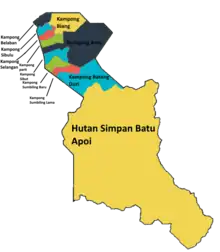
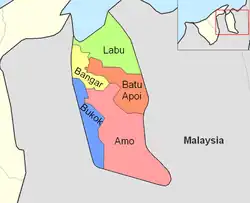
The district administration is the responsibility of Temburong District Office (Jabatan Daerah Temburong), a government department under the Ministry of Home Affairs.
Temburong District is divided into five mukims:
These are further subdivided into 76 Kampongs (Villages), however only 57 have a permanent population.
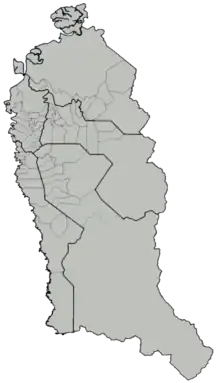
According to the Constitution, the district is to be represented in the Legislative Council, the state legislature, by up to 2 members.[7] As of 2017, one member has been appointed to represent the district in the legislature.[8]
Demographics
| Census Year | Pop. | ±% |
|---|---|---|
| 1971 | 5,224 | — |
| 1981 | 6,218 | +19.0% |
| 1991 | 7,688 | +23.6% |
| 2001 | 8,563 | +11.4% |
| 2011 | 8,852 | +3.4% |
| 2016 | 10,251 | +15.8% |
| Source: Department of Statistics[9] | ||
Temburong District is the least populous district in Brunei. According to the 2016 census update,[9] the population was 10,251 and made up about 2.5% of the country's total population. 52.2% were males and 47.8% were females. The racial make-up were as follow: 65.7% were Malays, 10.3% were Chinese, and 24% were those other than the aforementioned races. In terms of residency status, 80.7% were citizens, 12% were permanent residents and 7.3% were temporary residents. In terms of professed religions, 73.3% were Muslims, 13% were Christians, 1.3% were Buddhists, and 12.4% professed other than the aforementioned religions or irreligious. The age groups were as follow: 22% were 14 years old and below, 19.1% were 15 to 24 years old, 52.3% were 25 to 64 years old, and 6.5% were 65 years old and above. The population is predominantly rural, whereby 93.9% lived in rural areas in contrast to 6.1% in urban areas.
The census recorded 2,007 households living in 1,894 dwellings in the district.[9]
In 2020, the district's population was estimated to have increased to 11,200.[3]
Tourism
Much of the district is still covered by trees.[10] This leads to the intensive development of the eco-tourism industry in Temburong district. Eco-Tourism promotion events such as "Cuti-Cuti Temburong" ('Temburong holidays') were launched at the end of 2008 by the local tourism group known as "Kenali Negara Kitani" (KNK) ('Know Your Country') to encourage locals and tourists from foreign countries to travel to the Temburong district.[10] The promotion event is a kick-start of the Heart of Borneo project at Brunei vicinity.
Infrastructures
Education
In 2019,[11] there were 14 schools in Temburong District under the Ministry of Education, out of which 12 were government owned and 2 were private. The number of teachers was recorded at 238, in which 91.6% taught in public schools and 8.4% in private schools. The number of students was recorded at 1,816, whereby 90.7% were enrolled in public schools and 9.3% in private schools. For the formal Islamic religious education, which is under the Ministry of Religious Affairs, there were 12 religious schools (7.6% of the country's total), employing 106 teachers and enrolling 770 students.
The highest education level available in the district is secondary and its provided at the Sultan Hassan Secondary School, the sole secondary school in the district.
Healthcare
Pengiran Isteri Hajjah Mariam Hospital is the district hospital. It was inaugurated on 3 September 1987.[12] Its construction cost was B$15 million; it sits on a 2.8-hectare (6.9-acre) site.[12] The hospital has 50 beds and clinical services, such as, maternity, dental, optical and intensive care units.[12] It is named after Mariam binti Abdul Aziz, the former second wife, and Pengiran Isteri (princess consort), of Sultan Hassanal Bolkiah.[12]
Roads
As of 2022, the district's road network comprised a total length of 235.11 kilometres (146.09 mi), out of which 71.4% were paved.[13]
The road network is connected to the rest of the country primarily via Sultan Haji Omar Ali Saifuddien Bridge, commonly known as Temburong Bridge, which traverses the Labu Forest Reserve and the Brunei Bay. The other end of the bridge terminates in Brunei-Muara District. There is also an alternative road which crosses the Brunei–Malaysia border and was paved through the Limbang District, in the Malaysian state of Sarawak. Prior to the opening of the bridge in 2020, the route which passes through Malaysia was the only land route to the rest of the country.
Security
The district has an army presence at Bangar Camp. The main police headquarters are located in Bangar, with numerous police posts around the district.
Use by SAF
The SAF Commandos regularly conducts jungle training in the district. A Singapore army camp is also located between Kampung Negalang and the town of Lakiun.
Notes
- ↑ "The Country's Priceless Green Jewel | Brunei's No.1 News Website". brudirect.com. 25 July 2018. Retrieved 30 June 2021.
- 1 2 3 "Temburong District" (PDF). p. 8. Retrieved 17 October 2017.
- 1 2 3 4 "Department of Economic Planning and Statistics - Population". www.deps.gov.bn. Retrieved 30 June 2021.
- ↑ Rasidah, H.A.B. (4 April 2009). "Project for in-depth study of local forests". The Brunei Times. Archived from the original on 9 April 2009.
- ↑ Abu Bakar, Rasidah (16 March 2020). "Temburong bridge opens to traffic today". The Scoop. Archived from the original on 19 March 2020. Retrieved 20 March 2020.
- ↑ Rabiatul, Kamit (10 May 2013). "Temburong bridge ready 2018". Brunei Times. Archived from the original on 3 December 2013. Retrieved 10 July 2013.
- ↑ "CONSTITUTIONAL DOCUMENTS" (PDF). www.agc.gov.bn. p. 179. Retrieved 27 October 2021.
- ↑ "Pelantikan keahlian Majlis Mesyuarat Negara baharu" (PDF). Pelita Brunei (in Malay). No. 62 #6 (published 14 January 2017). Jabatan Penerangan. 12 January 2017. pp. 1, 2. Retrieved 27 October 2021.
- 1 2 3 "Population and Housing Census Update Final Report 2016" (PDF). www.deps.gov.bn. Department of Statistics. December 2018. Retrieved 1 August 2021.
- 1 2 "Exploring Brunei in 'Cuti-Cuti Temburong". The Brunei Times. 6 December 2008. Archived from the original on 24 November 2009.
- ↑ BRUNEI DARUSSALAM STATISTICAL YEARBOOK 2019 (PDF). Department of Economic Planning and Statistics. 2020. ISBN 9789991772264. Retrieved 2 August 2021.
- 1 2 3 4 "New $15 million district hospital" (PDF). Brunei Darussalam Newsletter. October 1987. p. 5. Retrieved 22 April 2022.
- ↑ "Brunei Darussalam Statistical Yearbook 2022" (PDF).
References
- R. Hédl, M. Svátek, M. Dancak, Rodzay A.W., M. Salleh A.B., Kamariah A.S. A new technique for inventory of permanent plots in tropical forests: a case study from lowland dipterocarp forest in Kuala Belalong, Brunei Darussalam, In Blumea 54, 2009, p 124–130. Publié 30. 10. 2009.